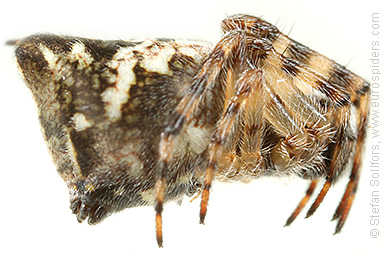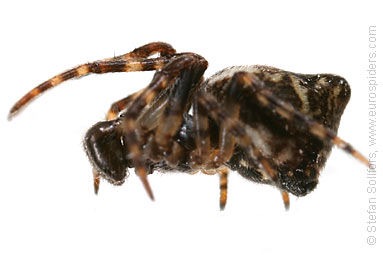Interactions
On the page I created about the habitat of the Cyclosa conica spider, I utilized a common theme throughout my writing comparing the Cyclosa’s habitat to your search for a dream home. As part of that analogy I asked you to picture what your ideal neighbors would be like. Would you prefer those that left you alone, or those that interacted with you? Well, this next page on our expedition through the life of the Cyclosa conica is dedicated to taking you through the journey of the social life of these spiders, their interactions with their neighbors, and how this species fits into the “social” hierarchy of its environment. Throughout this article you can expect to find information regarding the Cyclosa’s predation and food acquisition routines, enemies, and role as a potential host to a harmful parasite. Let’s get started!
How does the Cyclosa spider satisfy its intense and
all-consuming cravings for food? Well, they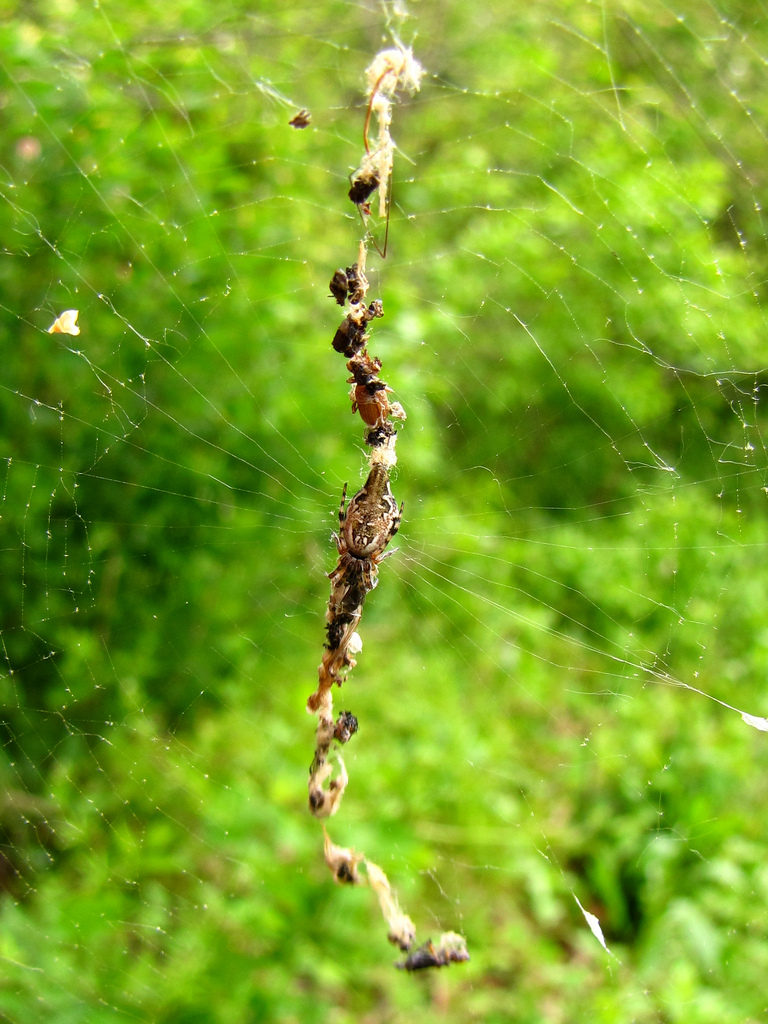 can be seen as
backstabbing and deceiving “neighbors” to members of the Dipterans
(order of flies) such as
Tabanus longiglossus (horsefly) and Hymenopterans
(insect order)such as
Dolichovespula maculate (hornet) (Tso 1998) who become unsuspecting meals for the
Cyclosa. This
clever spider’s predation strategy utilizes its
home to lure unsuspecting prey into their
unforgiving wrath. The location of the web in the dark forest
understory, combined with the web’s composition of delicate silk (Tso 1998) and incredibly thin mesh
that is 2.5 +/- .05 mm in diameter (Opell 2001) makes this web the
perfect trap for unsuspecting prey. The web decorations, or
stabilimenta, located vertically down the center of the web act as a
type of camouflage for the spider (Tso 1998). Tso
found that when stabilimenta were present in webs Cyclosa
captured 150% more prey (Tso 1998). Once captured, the spider
incorporates the remains of the victim into its stabilimenta in a
sort of vicious predation cycle (Tso 1998). This is one reason why I
am thrilled that Cyclosa doesn’t enjoy the taste of humans!
can be seen as
backstabbing and deceiving “neighbors” to members of the Dipterans
(order of flies) such as
Tabanus longiglossus (horsefly) and Hymenopterans
(insect order)such as
Dolichovespula maculate (hornet) (Tso 1998) who become unsuspecting meals for the
Cyclosa. This
clever spider’s predation strategy utilizes its
home to lure unsuspecting prey into their
unforgiving wrath. The location of the web in the dark forest
understory, combined with the web’s composition of delicate silk (Tso 1998) and incredibly thin mesh
that is 2.5 +/- .05 mm in diameter (Opell 2001) makes this web the
perfect trap for unsuspecting prey. The web decorations, or
stabilimenta, located vertically down the center of the web act as a
type of camouflage for the spider (Tso 1998). Tso
found that when stabilimenta were present in webs Cyclosa
captured 150% more prey (Tso 1998). Once captured, the spider
incorporates the remains of the victim into its stabilimenta in a
sort of vicious predation cycle (Tso 1998). This is one reason why I
am thrilled that Cyclosa doesn’t enjoy the taste of humans!
There are many “angry neighbors” or predators of the Cyclosa
conica who aim to take down this intelligent organism. An
experiment conducted by I-Chia Chou and a group of fellow
researchers te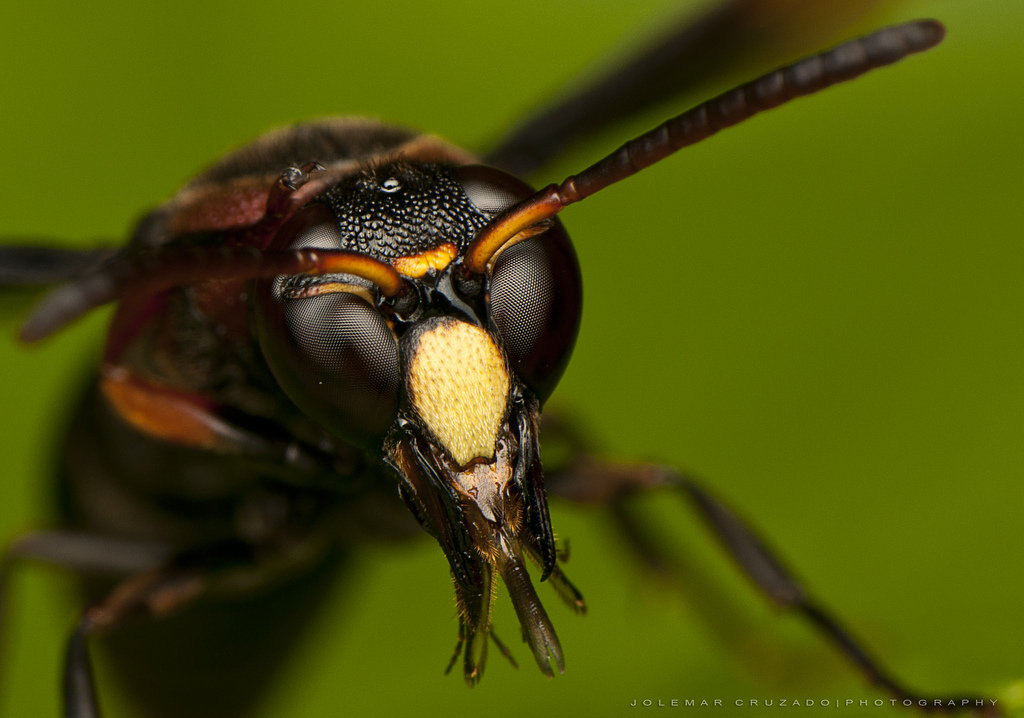 sted the ability of stabilimenta within webs to deter
the Cyclosa from predatory actions of the paper wasp, or
Vespa affinis (Chou et al. 2005). A close relative in the
same genus as this organism has also been found to feed on spider
varieties. This organism is called the
Asian Giant Hornet. Surprisingly, the
research concluded that Cyclosa’s who built undecorated
webs
were attacked less frequently than those with decorations
incorporated
into their web structure (Chou et al. 2005). However, the wasp’s
intended target when attacking the decorated-web spider was the
stabilimenta instead of the actual Cyclosa (Chou et al.
2005). This means that these web decorations act as a camouflage
and a decoy for the spider. Another infamous predator of the
Cyclosa spider is the notch-eared bat (Kervyn et al. 2012). The
Cyclosa don’t get as lucky as with the previous predator when
it comes to this endangered organism. This extremely receptive bat
forages near forest edges where the Cyclosa resides and
utilizes echolocation and the faint buzzing of prey stuck in their
webs to find and attack the Cyclosa on its web (Kervyn
et al. 2012). Another predator of this magnificent spider is the
Western Fence Lizard that can be found in the Cyclosa
homes all throughout the Angelo Reserve. This tests the theory of
keeping your friends close and your enemies closer!
sted the ability of stabilimenta within webs to deter
the Cyclosa from predatory actions of the paper wasp, or
Vespa affinis (Chou et al. 2005). A close relative in the
same genus as this organism has also been found to feed on spider
varieties. This organism is called the
Asian Giant Hornet. Surprisingly, the
research concluded that Cyclosa’s who built undecorated
webs
were attacked less frequently than those with decorations
incorporated
into their web structure (Chou et al. 2005). However, the wasp’s
intended target when attacking the decorated-web spider was the
stabilimenta instead of the actual Cyclosa (Chou et al.
2005). This means that these web decorations act as a camouflage
and a decoy for the spider. Another infamous predator of the
Cyclosa spider is the notch-eared bat (Kervyn et al. 2012). The
Cyclosa don’t get as lucky as with the previous predator when
it comes to this endangered organism. This extremely receptive bat
forages near forest edges where the Cyclosa resides and
utilizes echolocation and the faint buzzing of prey stuck in their
webs to find and attack the Cyclosa on its web (Kervyn
et al. 2012). Another predator of this magnificent spider is the
Western Fence Lizard that can be found in the Cyclosa
homes all throughout the Angelo Reserve. This tests the theory of
keeping your friends close and your enemies closer!
Parasitism can be compared to a “neighbor” that comes to visit
and won’t leave under any circumstances. This annoyance tends to
mooch off of the host for the benefit of only themselves. A common
phenomena among numerous spiders, including Cyclosa conica,
is symbioses with bacteria (Stefanini and Duron 2012). In some
cases, these symbioses turn out to be reproductive parasites that
attack the reproductive system of its host in order to spread its
species further into a population (Stefanini and Duron 2012). The
spread of these organisms is facilitated through the cytoplasm of a
female’s egg that is inherited from the mom (Stefanini and Duron
2012). This particular bacteria of interest regarding the
Cyclosa, Cardinium, has only recently been discovered
and the full effects of it are still being determined (Stefanini and
Duron 2012). So far, it has been found that 6-7% of arthropods have
this bacteria within th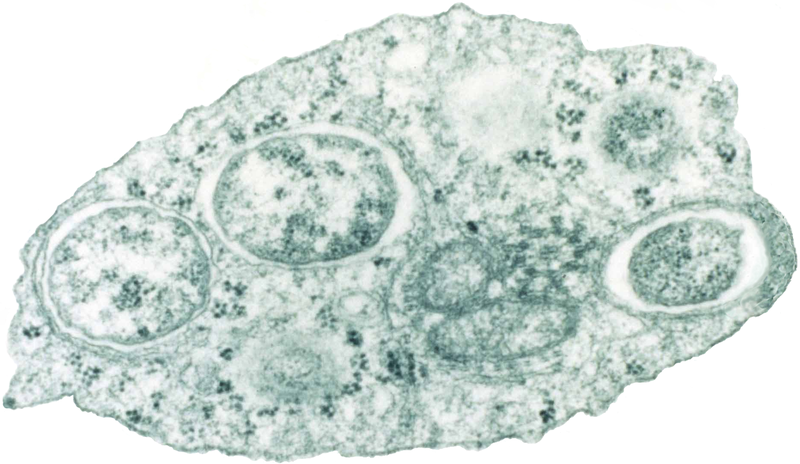 emselves (Vera et al. 2012). Albeit the small
numbers, this is pretty substantial considering the diversity
surrounding arthropods. Certain negative effects of this parasite
that have been discovered are feminization, thelytokus
parthenogenesis, and cytoplasmic incompatibility (Vera et al. 2012).
Woah, now those are some confusing terms, let’s break these down!
Feminization is basically making males more feminine by changing
their characteristics to be those of the females (Stefanini and
Duron 2012). Thelytokus parthenogenesis simply put is when eggs that
are unfertilized end up producing daughters that have two sets of
chromosomes, also known as diploid organisms (Pearcy et al. 2006). Cytoplasmic
incompatibility is a complex concept where parasites, such as
Cardinium, change aspects of the egg and sperm so that they
cannot combine to create working offspring (Stefanini and Duron
2012). These all aim to change the gender of the host organism to
female and to promote the production and survival of daughters. This
is because females are the vessel utilized to spread this parasite
(Stefanini and Duron 2012). This bacteria has been found in
Cyclosa conica, but the details about whether it actively
infects the organism as a parasite are to be determined (Stefanini
and Duron 2012). This being said, stay tuned in the lively drama of
the life of a Cyclosa conica to see how this dilemma turns
out.
emselves (Vera et al. 2012). Albeit the small
numbers, this is pretty substantial considering the diversity
surrounding arthropods. Certain negative effects of this parasite
that have been discovered are feminization, thelytokus
parthenogenesis, and cytoplasmic incompatibility (Vera et al. 2012).
Woah, now those are some confusing terms, let’s break these down!
Feminization is basically making males more feminine by changing
their characteristics to be those of the females (Stefanini and
Duron 2012). Thelytokus parthenogenesis simply put is when eggs that
are unfertilized end up producing daughters that have two sets of
chromosomes, also known as diploid organisms (Pearcy et al. 2006). Cytoplasmic
incompatibility is a complex concept where parasites, such as
Cardinium, change aspects of the egg and sperm so that they
cannot combine to create working offspring (Stefanini and Duron
2012). These all aim to change the gender of the host organism to
female and to promote the production and survival of daughters. This
is because females are the vessel utilized to spread this parasite
(Stefanini and Duron 2012). This bacteria has been found in
Cyclosa conica, but the details about whether it actively
infects the organism as a parasite are to be determined (Stefanini
and Duron 2012). This being said, stay tuned in the lively drama of
the life of a Cyclosa conica to see how this dilemma turns
out.
<< Reproduction
References
Facts>>
